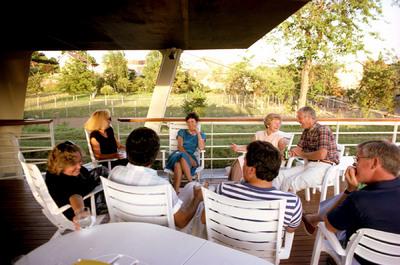- MENU
- HOME
- SEARCH
- WORLD
- MAIN
- AFRICA
- ASIA
- BALKANS
- EUROPE
- LATIN AMERICA
- MIDDLE EAST
- United Kingdom
- United States
- Argentina
- Australia
- Austria
- Benelux
- Brazil
- Canada
- China
- France
- Germany
- Greece
- Hungary
- India
- Indonesia
- Ireland
- Israel
- Italy
- Japan
- Korea
- Mexico
- New Zealand
- Pakistan
- Philippines
- Poland
- Russia
- South Africa
- Spain
- Taiwan
- Turkey
- USA
- BUSINESS
- WEALTH
- STOCKS
- TECH
- HEALTH
- LIFESTYLE
- ENTERTAINMENT
- SPORTS
- RSS
- iHaveNet.com: Travel
Barge Voyage in France's Champagne Region
By Lisa Rogak

French Barge Cruise
On a luxury barge trip in the Champagne region of France with French Country Waterways, you'll find bubbles both in your glass and as you cruise along the rivers and extensive French canal system.
There are several barge companies operating European river cruises in France, but French Country Waterways is one of the best, with 25 years of experience running trips throughout the country with well-seasoned crews and chefs.
Groups on each weeklong cruise are small -- maximum capacity on the barges ranges from eight to 18 -- and strangers become fast friends as they eat, drink and trade stories while exploring France together.
Many times, couples that meet on one trip repeat the experience together on future cruises.
SETTING OUT
We boarded the Adrienne in the town of Maizy on a lazy Sunday afternoon, which just happened to be July 14, or Bastille Day, France's Independence Day. (On alternate weeks, the boarding point is Château-Thierry, a town that was the site of the Battle of Château-Thierry during World War I.) The next morning, the barge was already underway when breakfast was served. We went up on deck to get into the swing of things, and by the looks of it, no one had trouble slowing down to the boat's relaxed pace of 4 mph. As we floated down the canal, warmed by the morning sun and lulled by the sounds of water splashing against the hull, we waved to old men fishing and families cooking their fresh catch on charcoal grills.
It wasn't unusual for people on the barge to read a few pages of a paperback, lay the book down for a catnap and then wake to stare out at the passing scenery before picking up the book again to repeat the cycle. If you like, you can get off the barge and stretch your legs with a walk along the towpaths or even take one of the bicycles on board to go for a ride.
DAY-TRIPPING
Glen Moynan, the Adrienne's captain, is a World War I history buff, and our day trips -- and much conversation about the towns we passed -- focused on this era. Part of the canal we traveled served as the boundary of the western front during the war. The Germans drained the canal to use as a dry moat, and in the woods you can still find poles for barbed wire fences, ordnance parts and bones. At one point Moynan jumped off the barge to retrieve a few treasures, brought them on board to show us, and hopped back off to return them.
Each day, there's one shore excursion. One morning we disembarked and drove through the town of Ludes, home to numerous small wineries. As we zipped through narrow village streets, rows of grapevines stretched as far as the eye could see. At the end of every few rows, there was a rosebush planted alongside. They serve as canaries in a coalmine, to warn vineyard workers of the potential for blight, since roses are more fragile than grapes and reveal possible threats earlier. We visited Canard Duchaine, the largest Champagne house in town, and Ployez Jacquemart, a smaller, family-run Champagne house, and wandered through the caves where endless stacks and rows of bottles are stored. Of course, we were obliged to sample the products at each.
We also saw signs that said, in essence, the vines covering one complete hillside were owned by one vineyard: Moet & Chandon. Later in the week, our day excursion to the city of Reims included a tour and lunch at the Moet & Chandon headquarters in nearby Epernay to tie everything together.
THE FOOD
For many, the meals are the most memorable part of the barge trip, with a professionally-trained chef who takes full advantage of fresh local produce, meats and cheeses, Indeed, it was the norm to have five different selections at lunch: crab salad in avocado, warm chicken salad stuffed in zucchini, tabbouleh, feta cheese and a green salad. At each meal, two wines -- one red and one white -- were served. On top of that, at meal's end, three cheeses were offered. At dinner the dishes were more elaborate, but different red and white wine and three cheeses were still the rule.
TINY BUBBLES
The French canal system uses an extensive system of locks to aid boats and barges to navigate the waterways. As you go through the locks, you'll want to witness the action at least once from the porthole of your bedroom. As the barge goes down, water rushes around the hull, producing a plethora of bubbles, and it's easy to imagine this is what it must be like to be inside a washing machine looking out.
French Country Waterways is American-owned and operated. Besides the Champagne region, the company offers barge cruises in the Burgundy, Upper Loire and Alsace-Lorraine regions of France. (800-222-1236. www.frenchcountrywaterways.com.)
© Travel Muse Distributed by Tribune Media Services, Inc.
AUTOS | HOBBIES | EDUCATION | FAMILY | FASHION | FOOD & RECIPES | HOME DECOR | RELATIONSHIPS | PARENTING | PETS | TRAVEL | WOMEN
Vacation Travel - Barge Voyage in France's Champagne Region